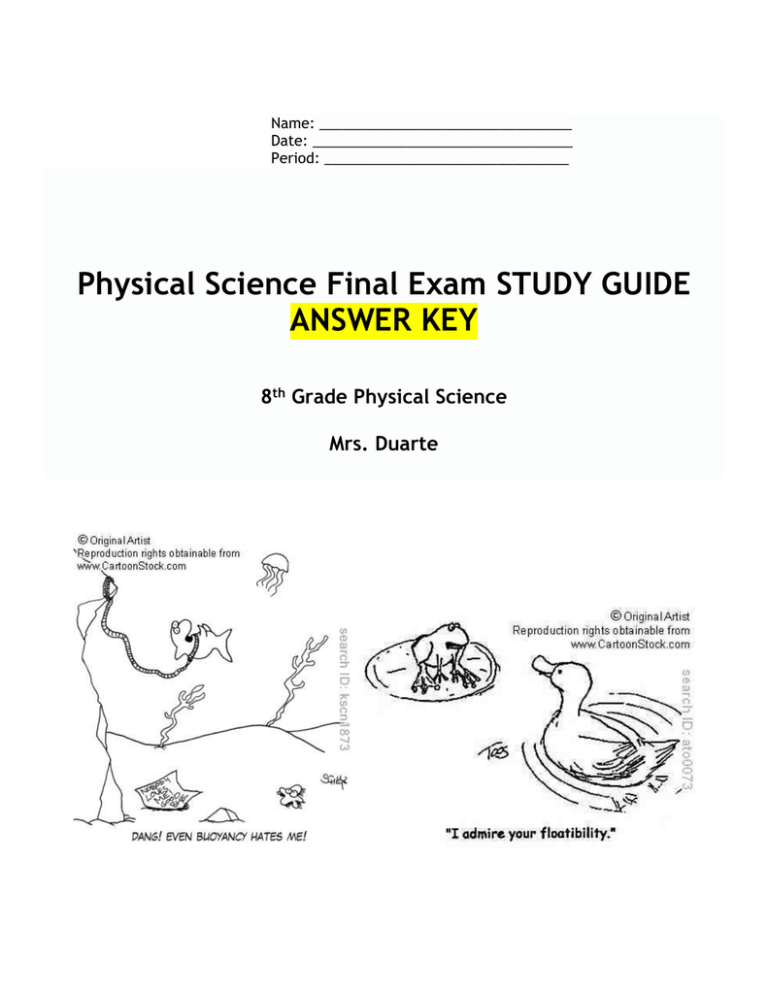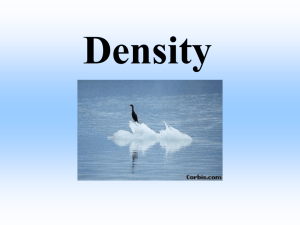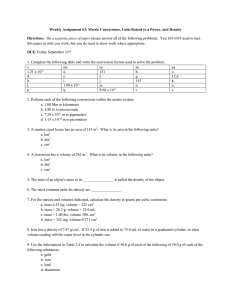Physical Science Final Exam STUDY GUIDE ANSWER KEY 8 th
advertisement

Name: ________________________________ Date: _________________________________ Period: _______________________________ Physical Science Final Exam STUDY GUIDE ANSWER KEY 8th Grade Physical Science Mrs. Duarte 1. What is the equation for density? (8.a) D= m / V (Density is mass (g or kg) divided by volume (mL or cm3) 2. Which of these units do scientists use for density? (8.a) a. Solid density: cm3 b. Liquid density: mL or L (liters) 3. A copper bar with a mass of 40 grams and a density of 20 g/cm3 is cut into three equal pieces. The density of each of the three smaller pieces is (8.a) a. b. c. d. One-third the density of the original bar One-sixth the density of the original bar Three times the density of the original bar. The same as the density of the original bar. 4. Proficient: The box below has a mass of 30 g. What is its density of the box? (8.b) 2 cm 2 cm 5 cm Volume (V) = l x w x v = (5 cm) x (2 cm) x (2cm) = 20 cm3 Density = m/v = (30g) / (20 cm3) = 1.5 g/ cm3 5. Proficient: The mass of a copper block is 50 g and the volume is 25 cm3. What is the density of the block? (8.b) D = m / V = (50g) / (25 cm3) = 2 g/ cm3 6. dvanced: The mass of a spoon is 25 g. Jaime filled a graduated cylinder with 50 mL of water and then put the spoon in. The water level rose to 55 mL. What is the density of the spoon? (8.b) V = 55mL – 50 mL = 5 mL D=m/V = (25g) / 5 mL = 5 g/mL 7. Advanced: Using the picture below, calculate the density of the black rock. (8.b) 20 mL 20 mL 15 mL 15 mL 10 mL 10 mL 5 mL 5 mL 20.0 g M = 40g – 20 g = 20 g D = m/V = 20g / 5 mL = 4 g/mL 40.0 g V = 15 mL – 10 mL = 5 mL FORCES 8. A spacecraft that is far from any planets moves with all forces acting on it in balance. As a result, will the spacecraft accelerate? Why or why not? No, if all forces are balanced, there will be no net change in the velocity, it will remain constant, therefore no acceleration ( acceleration is change in velocity (change in speed)) 9. How big would the force have to be to move to the left? At least 12 N or more! A force to the left greater than 11 N would overcome the force pushing to the right and produce net movement to the left. 12. The gravitational force acts on matter in all directions so that stars and planets tend to take on the shape of a A. Cylinder B. Disc C. Sphere D. Irregular shape 13. What is the equation for calculating Force? F = m x a (Force = mass x acceleration) 14. A watermelon is thrown across the room with a force of 18 Newtons and accelerates at a rate of 6 m/s2. What was the mass of the watermelon? F=mxa m = F/a = (18 N/ 6m/s2) = 3 kg CHEMICAL REACTIONS 14. Advanced: Burning gasoline and boiling water both produce gases. Burning gasoline is a chemical change, but boiling water is not a chemical change. (5.a) Why is that the case? Burning gasoline produced a NEW substance, and signs of chemical reaction took place are burning, smoke, and odor change (doesn’t exhaust of a car smell bad?). Water boiling just converts water from a liquid state to a gas state, but it’s chemical composition has NOT change, it’s still H20!! 15. Advanced: Carmen's father told her not to leave her bike outside because rain would make the bike's metal frame turn into rust (Fe2O3) faster. The frame was made of mostly iron (Fe). Which of these statements BEST explains how the rust would form? (5.a) a. The water molecules would combine with the iron to form rust. b. In the presence of water, the iron would melt and turn into rust. c. The rain contains acid that would combine with the iron to form rust. d. In the presence of water, oxygen would combine with the iron to form rust. 16. Proficient: This following chemical equation represents what happens when a nail rusts. Is the equation balanced? (5.b) 4Fe + 3O2 2Fe2O3 4 - Fe -4 (2 x 2) 6 (3x2) – O- -6 (2x3) Yes, it is balanced because there are the same number of atoms of each element, Fe and O, on both sides of the equation. 17. Proficient: You pour 30 grams of hydrogen peroxide on 10 grams of liver. Assuming they react completely with each other, what is the total mass of the product? (5.b) 40g because of the Law of Conservation of Mass – you always end with the SAME amount of material that you started with! (30g + 10g = 40g) 18. Proficient: The diagram below shows hydrogen reacting with oxygen to produce water. (5.b) Which of these characteristics will remain unchanged during the reaction? (5.b) a. The number of atoms b. The number of molecules c. The temperature of the reaction d. The chemical properties of the molecules 19. Advanced: Two units of magnesium (Mg) combine with one unit of oxygen (O2) to create two units of magnesium oxide (MgO): (5.b) 2Mg + O2 2MgO If there are 2 atoms of oxygen in the reactants, how many atoms of oxygen will be in the product? (5.b) 2 atoms of Oxygen in the product because mass will always be conserved in a chemical reaction according to the law of conservation of mass. 20. Advanced: Methane (CH4) burns in oxygen (O2), forming carbon dioxide (CO2) and water (H2O). Which diagram shows this process accurately? (5.b) a. CH4 + O2 CO2 + H2O b. CH4 + O2 CO2 + 2H2O c. CH4 + 2O2 CO2 + 2H2O d. CH4 + 3O2 CO2 + H2O





